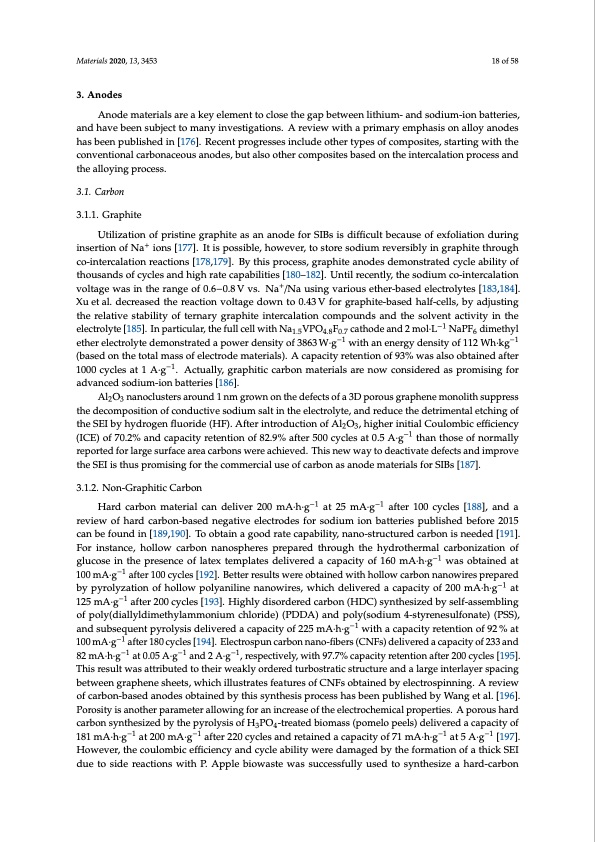
PDF Publication Title:
Text from PDF Page: 018
Materials 2020, 13, 3453 18 of 58 3. Anodes Anode materials are a key element to close the gap between lithium- and sodium-ion batteries, and have been subject to many investigations. A review with a primary emphasis on alloy anodes has been published in [176]. Recent progresses include other types of composites, starting with the conventional carbonaceous anodes, but also other composites based on the intercalation process and the alloying process. 3.1. Carbon 3.1.1. Graphite Utilization of pristine graphite as an anode for SIBs is difficult because of exfoliation during insertion of Na+ ions [177]. It is possible, however, to store sodium reversibly in graphite through co-intercalation reactions [178,179]. By this process, graphite anodes demonstrated cycle ability of thousands of cycles and high rate capabilities [180–182]. Until recently, the sodium co-intercalation voltage was in the range of 0.6−0.8 V vs. Na+/Na using various ether-based electrolytes [183,184]. Xu et al. decreased the reaction voltage down to 0.43 V for graphite-based half-cells, by adjusting the relative stability of ternary graphite intercalation compounds and the solvent activity in the electrolyte [185]. In particular, the full cell with Na1.5VPO4.8F0.7 cathode and 2 mol·L−1 NaPF6 dimethyl ether electrolyte demonstrated a power density of 3863 W·g−1 with an energy density of 112 Wh·kg−1 (based on the total mass of electrode materials). A capacity retention of 93% was also obtained after 1000 cycles at 1 A·g−1. Actually, graphitic carbon materials are now considered as promising for advanced sodium-ion batteries [186]. Al2O3 nanoclusters around 1 nm grown on the defects of a 3D porous graphene monolith suppress the decomposition of conductive sodium salt in the electrolyte, and reduce the detrimental etching of the SEI by hydrogen fluoride (HF). After introduction of Al2O3, higher initial Coulombic efficiency (ICE) of 70.2% and capacity retention of 82.9% after 500 cycles at 0.5 A·g−1 than those of normally reported for large surface area carbons were achieved. This new way to deactivate defects and improve the SEI is thus promising for the commercial use of carbon as anode materials for SIBs [187]. 3.1.2. Non-Graphitic Carbon Hard carbon material can deliver 200 mA·h·g−1 at 25 mA·g−1 after 100 cycles [188], and a review of hard carbon-based negative electrodes for sodium ion batteries published before 2015 can be found in [189,190]. To obtain a good rate capability, nano-structured carbon is needed [191]. For instance, hollow carbon nanospheres prepared through the hydrothermal carbonization of glucose in the presence of latex templates delivered a capacity of 160 mA·h·g−1 was obtained at 100 mA·g−1 after 100 cycles [192]. Better results were obtained with hollow carbon nanowires prepared by pyrolyzation of hollow polyaniline nanowires, which delivered a capacity of 200 mA·h·g−1 at 125 mA·g−1 after 200 cycles [193]. Highly disordered carbon (HDC) synthesized by self-assembling of poly(diallyldimethylammonium chloride) (PDDA) and poly(sodium 4-styrenesulfonate) (PSS), and subsequent pyrolysis delivered a capacity of 225 mA·h·g−1 with a capacity retention of 92 % at 100 mA·g−1 after 180 cycles [194]. Electrospun carbon nano-fibers (CNFs) delivered a capacity of 233 and 82 mA·h·g−1 at 0.05 A·g−1 and 2 A·g−1, respectively, with 97.7% capacity retention after 200 cycles [195]. This result was attributed to their weakly ordered turbostratic structure and a large interlayer spacing between graphene sheets, which illustrates features of CNFs obtained by electrospinning. A review of carbon-based anodes obtained by this synthesis process has been published by Wang et al. [196]. Porosity is another parameter allowing for an increase of the electrochemical properties. A porous hard carbon synthesized by the pyrolysis of H3PO4-treated biomass (pomelo peels) delivered a capacity of 181 mA·h·g−1 at 200 mA·g−1 after 220 cycles and retained a capacity of 71 mA·h·g−1 at 5 A·g−1 [197]. However, the coulombic efficiency and cycle ability were damaged by the formation of a thick SEI due to side reactions with P. Apple biowaste was successfully used to synthesize a hard-carbonPDF Image | Electrode Materials for Sodium-Ion Batteries

PDF Search Title:
Electrode Materials for Sodium-Ion BatteriesOriginal File Name Searched:
materials-13-03453-v2.pdfDIY PDF Search: Google It | Yahoo | Bing
Salgenx Redox Flow Battery Technology: Salt water flow battery technology with low cost and great energy density that can be used for power storage and thermal storage. Let us de-risk your production using our license. Our aqueous flow battery is less cost than Tesla Megapack and available faster. Redox flow battery. No membrane needed like with Vanadium, or Bromine. Salgenx flow battery
| CONTACT TEL: 608-238-6001 Email: greg@salgenx.com | RSS | AMP |